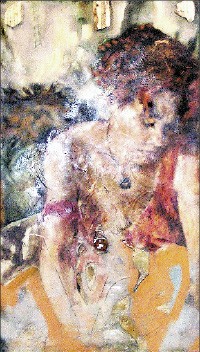It’s closing time for some great art exhibits this weekend. We’ve got Meikle Gardner lampooning the state of society, and Anton Weiss looking back on his long career. There’s Deborah Brown taking portraiture to a new level, and James Clar lighting things up.
For his current exhibition, “Meikle Gardner” at Perry Nicole Fine Art, Gardner combines striking palettes and semiabstract shapes to create surreal, sci-fi, and 21st-century scenarios. Roadways fling out asteroids (Levitation Road) and spring-green tendrils grow human body parts (Primordial).
In the largest painting in the exhibit, Three Alarm Circus, wrecking balls and trapezes appear to swing in syncopation across the top of the painting. This work is a chaotic concoction of lavenders and oranges and takes us for a circus ride — across three-alarm political arenas, three-alarm environmental devastation, and three-alarm war zones. In between red-orange flames that lick upward from the bottom of the painting and the high-wire act at the top, a contortionist twists, bends over backward, and changes shape as well as position. A gold ring hangs down from its bull-like cartoon face and a wind-up key protrudes from the side of its booted heel. Pulled around by the nose, all wound up, and caught between wrecking balls and a fiery pit, Three Alarm Circus succeeds as bold design, as cautionary tale, and as sardonic metaphor for our world today.
In “Anton Weiss: Seven Decades,” the current exhibition at L Ross Gallery, Weiss takes a wry look at himself and translates a long life into zany totems, ancient architecture, spacescapes, and Zen landscapes. Weiss handles his welding torches and grinders as fluidly as brushes and palette knives. In Transformation, for instance, he welds slender bars of steel into what looks like an electrical current coursing through a cartoon character’s large frazzled head.
Beautiful and complex like the colors and patterns of erosion, Lode Star (acrylic on canvas) is a poignant reminder that all things human-made (buildings, monuments, and paintings) are subject to change and decay. Faded circles appear to float across fields of light ochre, burnt sienna, and blue-gray. Near top center, Weiss scrapes through some squares and rectangles, scumbles their lines and colors, reveals several layers of underpainting, and creates the semblance of an ancient, crumbling cityscape.
Weiss’ abstract geometries and color fields also suggest spacescapes. In Seven Decades Series – 007, a pale golden orb floats in a thin atmosphere of light grays and ochres (acrylic stains, copper on aluminum). New to the artist’s oeuvre are several untitled Zen-like landscapes in which traces of color and faint gestures are painted onto sheets of metal. These simultaneously delicate and durable works are particularly apropos for an artist who, at 70, understands both life’s fragility and its enduring passions.

Deborah Brown is a skilled figure painter. In one of the large, untitled mixed-media works in “Resonance,” the current exhibition at the Jay Etkin Gallery, she beautifully captures skin tones, clothing textures, and the expression of a woman lost in thought, a slight smile playing across her lips. But Brown isn’t interested in traditional portraiture. Most of the canvases in this body of work are tarred, torn, stapled, nailed, burned, waxed, and/or collaged with broken mirrors.
In a diptych thick with wax and pigment, we can just make out the backs and the relaxed shoulders of two women whose body language suggests that they are quietly reflecting. In another multilayered work, only a woman’s face is visible, partially obscured by broken shards of mirror. Instead of appearing to be in pain or disoriented, the face behind the broken glass looks out with a steady, penetrating gaze. This could be the alter ego for an artist who says she sees “people reflected in each other” and explores the “textures of life.”
As you look into the cracked mirrors, behind the torn canvases, and at the figures absorbed in thought, some of your own memories and feelings may well up. As Brown has noted in previous interviews, that is what she hopes will happen.
James Clar, the first Lantana artist-in-residence at the FedEx Institute of Technology, is at a milestone in a relatively short but very full career. At age 27, he has already had a show at the Museum of Modern Art, won numerous awards for his 3D Display Cube, and designed a mesh of LEDs to light up an entire hotel in Barcelona. As a finale for his residency at the FedEx Institute, Clar is building an installation that will light up the rooftops of the South Main Arts District on Friday, April 28th.
Two of Clar’s light sculptures are on display at Material. The interactive piece Blue 88 consists of 14 fluorescent tubes of blue light arranged to look like the side-by-side figure eights on an LED clock face. You’re encouraged to turn the tubes on and off. As you reconfigure this sculpture, opening and closing its parameters, you may find yourself thinking about blue skies and the pervasive quality of the light that softly illuminates the tubes and the gallery space.
To create You and Me, Clar suspended fluorescent tubes of white light from the ceiling. In this uncharacteristically personal work, the artist pays tribute to his wife for the ways “she supports me and lets me shine.” Metal ballasts on the ceiling spelling out the word “you” represent his wife. The cool-white fluorescent tubes that spell out the word “me” refer to Clar — a particularly appropriate metaphor for an artist whose career, like light, seems to have no limits.